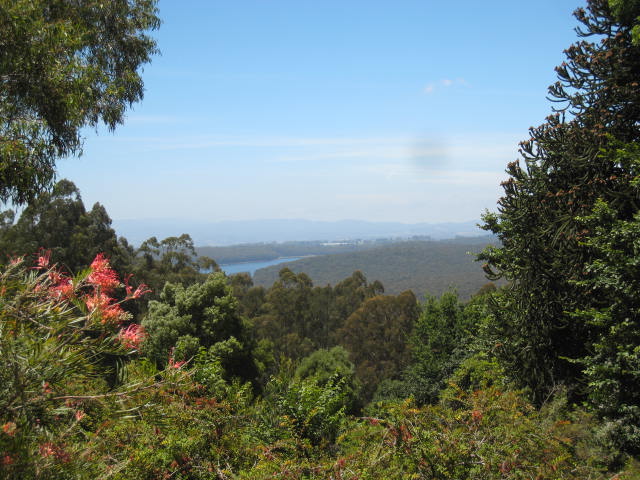Kalorama Park (Kalorama)


Boasting spectacular views over Silvan Reservoir and the south-eastern face of the Dandenong Ranges, Kalorama Park is perfect for picnics, barbecues or simply relaxing whilst enjoying the magnificent surrounds. Kalorama Park is bordered by lush temperate forest on the eastern side and Dandenong Ranges National Park to the north and south - both of which provide numerous walking opportunities.
Things to Do
- Enjoy a relaxing picnic in the area below the lower carpark which is surrounded by garden beds with elm trees, silver birch, pine trees and pin oaks, along with Australian native plants and ferns.
- An expansive grassy area near the upper carpark is an ideal setting to spread out the picnic blanket and enjoy lunch. The views over the south-eastern face of the Ranges are spectacular from the upper carpark. A number of large eucalypt trees and tree ferns in the area offer ample shade to escape the summer heat.
- Kalorama Lookout is located on the Mount Dandenong Tourist Road at the Five Ways intersection. The lookout provides one of the finest vantage points to view the Dandenong Ranges, surrounding foothills and Yarra Ranges in the distance.
- A number of short walking tracks commence from each of the three carparks. These tracks are ideal for a short stroll before or after your barbecue lunch. The tracks pass through native forest, historical fruit orchards and exotic plantings.
- Other bushwalking opportunities exist within the Doongalla section of the Dandenong Ranges National Park, located on Ridge Road opposite the Kalorama Lookout carpark (Melway ref: 52 H9).
- There are also a number of walking tracks in the Olinda section of the national park, located east of the lower carpark, down Barbers Road (Melway ref: 120 A12).
Facilities
- The picnic area below the lower carpark has two gas barbecues under the picnic shelter, making it the perfect place for a family or group get together.
- There are two toilet blocks located within the park. One is located just below the Lookout Carpark while the other is just above the main picnic area.
- A drinking fountain and water tap are located within the main picnic area near the picnic shelter.
Heritage
The first Europeans to settle in the Kalorama valley area were Isaac Jeeves, Mathew Child and Jabez Richardson, with their families. The three families built their homes along what was then called 'Running Creek', now known as Olinda Creek. In 1870, Jeeves sold part of his allotment to Thomas Hand, who was a surveyor with the Upper Yarra Road Board. This allowed Jeeves to purchase land in the 'Gap' which was named Jeeves Saddle, and is now known as 'Five Ways'.
The Jeeves family, through son Ellis and grandsons Hubert and Walter, retained ownership of part of the original title of land for nearly 100 years. During this time the entire open section of the park was cleared of its natural vegetation, for logging and grazing purposes. In 1963, the State Government purchased 13 hectares from the Jeeves family, followed by another nine hectares of adjoining land later on.
The 'Save the Dandenong's League' was instrumental in the purchase of this land to conserve it from further development and raised half the cost through subscriptions and a public appeal.
Relics that still remain are the old farm shed, thought to be built by the Jeeves family in the 1940s, and the barbecue pavilion built by the Forest Commission to commemorate the site where Ellis Jeeves built a house.
Fauna
The forest supports a diversity of wildlife. Stay alert and you may be surprised at what you see. Mistletoe Birds, Yellow Robins, Eastern Whipbirds, Crimson Rosellas and Golden and Rufous Whistlers are just some of the more commonly seen birds in the park.
Nocturnal animals include Common Ringtail and Brushtail Possums, Sugar Gliders, Black Wallabies, wombats and echidnas.
Vegetation
Remnant Mountain Ash forest covers the eastern section of the park. This type of forest was prominent throughout the Dandenong Ranges before European settlement and the resulting widespread clearing.
Mountain Ash trees can reach heights of up to 150 metres and may live for 400 years - due to a number of fires the oldest are around 150 years in age.
There are three distinct layers of vegetation below the canopy of Mountain Ash trees. Ferns and grass species make up the ground cover, with the mid-storey comprising Hazel Pomaderris, Blanket Leaf, Soft and Rough Tree Ferns, Musk Daisy Bush and Blackwood Wattles.
Kalorama Park features around 80 orchard trees planted by the Jeeves family over 100 years ago. The orchard area consists of plum, apple, peach and walnut trees that are scattered through open cleared grasslands.
Other historically significant trees of Kalorama Park include two Elm trees above the five ways carpark, which were planted by the Jeeves family to mark the gateway to the original property.
Remnants of the original formal garden beds still remain today and have been restored with recent plantings of azaleas, rhododendrons, native ferns and grasses.
Opening Hours:
Open all hours
Cost:
Free
Review:
There are some lovely short walks (less than an hour return) which passes through a Mountain ash forest and cool, shaded fern gullies. We took the path to Jeeves Avenue and returned back the same way. The path is steep in sections and could be very slippery when it is wet. There are picnic facilities but the number of tables is quite limited. At the top of the hill is a lookout with lovely views and a cafe.
Photos:
Location
6 Yosemite Road, Kalorama 3766 View Map
Web Links
→ Dandenong Ranges National Park (Parks Victoria)
→ The Best Family Activities in the Dandenong Ranges








